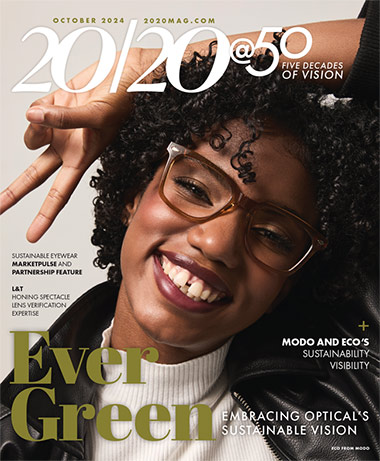
20/20 Magazine turns 50 this summer. Fifty years is a point at which we can see the past and look to the future at the same time. As journalist Bill Dedman said, “History is the best guide to the future.” Over the last 50 years, 20/20 has reported the events and innovations that have become the history of our industry, always with anticipation of the future.
Earlier this year, I researched the archives of 20/20, and even got my hands on some pre-internet hard copies, which I handled with extreme care. It was an amazing journey! As the chronology of our industry unfolded, I saw each new development morph into the next and the next. I’ve been in optical long enough to have had some “I remember when that came out!” moments and realized how each event changed what we knew and how we did things in ways big and small.
In addition to new products, 20/20 reported some interesting and somewhat surprising facts. For example, in 1974, there were an estimated five million hard contact lens wearers, but only 350,000 soft lens wearers. Designer names didn’t begin appearing on frames until 1976. Cheryl Tiegs became the first supermodel for eyewear in 1985. Blister packs for contact lenses arrived in 1987. In 1990, 57.9 percent of women in the optical industry said their career paths would be easier if they were male. Lawrence DeLucas, OD, became the first optometrist in space in 1992. 1999 debuted 20/20’s first CE course in print, titled “Photochromic Lenses Do a Lot More Than Change Color.” Vision Expo was cancelled in 2001 due to the tragedy of 9/11. Plano contact lenses were reclassified as medical devices, not cosmetics, in 2005. 20/20 became the largest provider of ABO approved CE in the U.S. in 2012. And moving to more recent memory, there’s much more you can discover!
As for inventions, I’m sure you have your favorite for the greatest impact on the industry. For me, the Greatest Optical Invention of All Time (GOIAT) was Hilco’s Tap’n’Snap self-tapping screws in 1991. Yes, that may not be anywhere close to your all-time greatest, especially for something as simple as a screw, but for me it saved not only time, but my life when I didn’t die of a thousand screwdriver cuts.
Yes, 50 years is a great deal to look back on, but we also continue to look forward. A glance over the shoulder reveals that things happen quickly in this business, where something new happens nearly every day. What we can learn from the past will provide wisdom in the future.
• Linda Conlin
Pro to Pro Managing Editor
[email protected]












